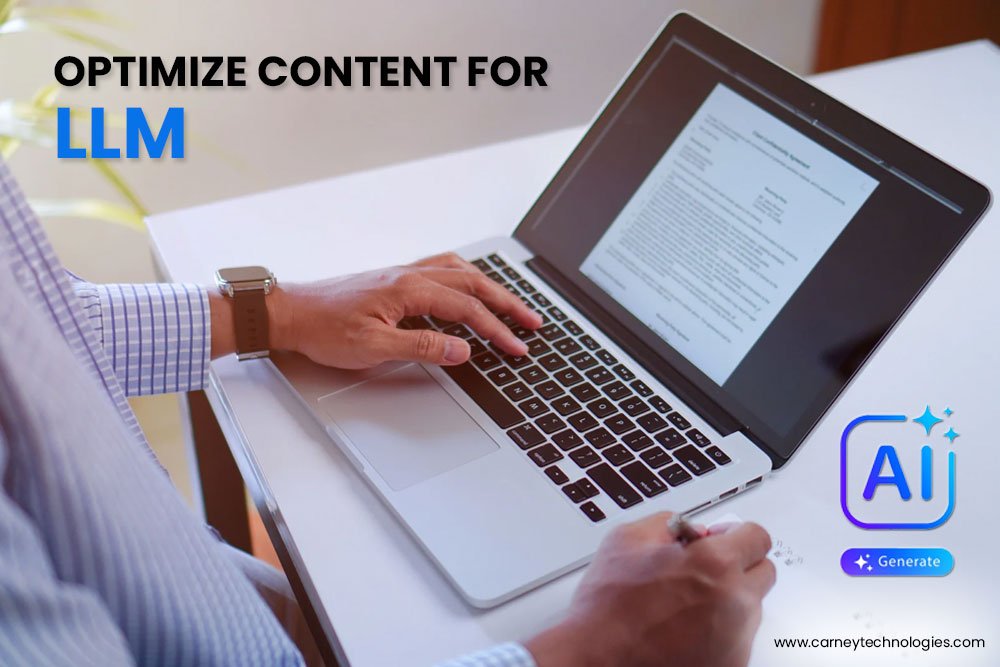The digital landscape is evolving rapidly with the rise of Large Language Models (LLMs) like ChatGPT, Gemini, and Claude. These AI systems are transforming how information is discovered, summarized, and delivered and traditional SEO alone is no longer enough. If you want your work to be visible, you must optimize content for LLMs. Unlike search engines, LLMs select and synthesize content based on clarity, authority, and relevance, not just keyword density or backlinks.
This guide will walk you through how to create LLM-friendly content that AI understands, trusts, and uses in responses. You’ll learn how to structure your content, signal authority, and meet AI-driven user intent, ensuring your content ranks and thrives in the AI-first future.
Why You Must Optimize Content for LLMs
We’re entering a new phase of digital visibility, one where Large Language Models (LLMs) like ChatGPT, Gemini, and Claude play a growing role in how content is surfaced and consumed.
For years, content creators have focused on ranking in search engines using traditional SEO. But LLMs don’t operate the same way as Google’s algorithm. They don’t just rank, they summarize, synthesize, and cite content based on how well it answers user questions, how clearly it’s written, and how trustworthy it appears.
That means it’s time to optimize content for LLMs, not just for search engines. If your blog posts, guides, or articles aren’t structured in a way that LLMs can understand and extract from, they’re less likely to be surfaced in AI-generated answers, summaries, or chat interfaces.
- This new frontier demands a shift in strategy:
- From keyword density to conversational clarity
- From backlinks to trust signals
- From content length to content usefulness
In this guide, you’ll learn exactly how to optimize your content so LLMs recognize it as relevant, authoritative, and reliable, increasing the chances it will be selected, summarized, or even quoted in AI-generated responses.
The New Frontier of Content Visibility
The rules of online visibility are changing fast.
Large Language Models (LLMs) such as ChatGPT, Claude, and Gemini are no longer just tools for answering questions; they are now gatekeepers of information. From summarizing blog posts to generating detailed explanations, these AI systems are influencing which content gets seen and which gets ignored.
For content creators, marketers, and businesses, this shift marks a turning point. Traditional SEO, while still valuable, is no longer sufficient. To stay visible and relevant, you need to optimize content for LLMs, making your articles, guides, and resources more accessible and valuable to AI systems that prioritize clarity, credibility, and relevance.
This guide will equip you with the core strategies to ensure your content is:
- Structured for AI comprehension
- Written in a natural, human tone
- Backed by authoritative sources
- Aligned with modern user intent
As LLMs become the primary interface between users and information, your ability to adapt will determine your visibility. By learning how to optimize content for LLMs, you’ll future-proof your content strategy and ensure your voice is heard, even in AI-driven spaces.
Understanding LLM "Ranking": It's More than Just Keywords
When we talk about how to optimize content for LLMs, it’s important to recognize that “ranking” doesn’t work the same way as it does with traditional search engines like Google.
LLMs don’t display search results in a list of links. Instead, they generate responses by selecting, summarizing, or citing information from the content they have been trained on or have access to. This means that your goal isn’t to hit position #1 on a search engine results page. It’s to ensure your content is clear, relevant, and trustworthy enough for an LLM to pull from when answering a query.
What Does "Ranking" Mean in the LLM Context?
- Not a traditional SERP rank. You won’t see your content in a numbered list. Instead, you may be quoted, paraphrased, or summarized in an AI response.
- It’s about selection and inclusion. LLMs process huge volumes of data. To be included, your content must be easy to understand, authoritative, and aligned with the intent behind user queries.
- Focus on AI-friendly signals. Relevance, clarity, depth, and credibility are what LLMs prioritize. You must create content that is not only accurate but also structured in a way that makes sense to a language model.
Why LLMs Think Differently Than Search Engines
Unlike search engines, which often rely on keyword frequency, backlinks, and metadata, LLMs understand relationships between words, ideas, and context. They interpret meaning, tone, and structure to decide what information to use in a response.
So, stuffing keywords or repeating phrases will not help. In fact, it can work against you. The goal now is to create content that LLMs can easily interpret and trust.
The Shift: From Keywords to Comprehension
To optimize content for LLMs, you need to move beyond traditional SEO tactics. Your content should be written for intelligent systems that understand language much like a human does. That means prioritizing:
- Clear, logical structure
- Natural, conversational tone
- Depth and completeness of information
- Credible sources and factual accuracy
This is the foundation for modern content visibility. The more clearly you communicate valuable information, the more likely it is that LLMs will include your content in their answers.
The Pillars to Optimize Content for LLMs Effectively
If you want your content to be discovered, referenced, or quoted by AI tools like ChatGPT or Gemini, you need to build it on a foundation that LLMs understand and value.
To optimize content for LLMs, you must focus on five key pillars. These elements help LLMs process your writing, evaluate its credibility, and decide whether it should be used to generate answers.
Clarity and Structure: Making Content Easy for AI to Digest
LLMs favor content that is logically structured and easy to interpret. A clean layout with clearly defined sections improves your chances of being selected.
- Use clear, conversational language. Write the way you would explain something to a curious reader. Avoid jargon when possible and use simple, direct sentences.
- Organize with proper heading tags. Use H1 for the main title, H2 for major sections, and H3 for sub-points. This helps LLMs understand your content hierarchy.
- Break content into short paragraphs. Dense walls of text are hard to scan. Use bullet points and numbered lists to make key ideas stand out.
- Format for answers. Include headings in the form of questions and provide direct, concise answers underneath. This format is highly usable for AI outputs.
Authority and Trustworthiness: Build AI Confidence
LLMs prioritize information that comes from reliable, well-sourced, and knowledgeable creators.
- Cite reputable sources. Link to original research, government data, and established publications to back up your claims.
- Demonstrate E-E-A-T. Show your Experience, Expertise, Authoritativeness, and Trustworthiness by using real examples, thorough explanations, and transparent sourcing.
- Include author bios and contact details. These human elements help establish legitimacy.
- Increase your digital presence. Appear on other trusted websites, social platforms, and directories. Brand ubiquity supports authority in the eyes of both humans and AI.
Relevance and Comprehensiveness: Be the Best Answer
LLMs are designed to give complete answers to user questions. If your content only scratches the surface, it will likely be ignored.
- Cover topics in depth. Go beyond the basics and include advanced insights, supporting data, and practical examples.
- Anticipate follow-up questions. Address related topics that a reader would logically wonder about next.
- Align with search intent. Understand whether the reader wants a definition, a how-to guide, or a product comparison. Tailor your content to meet that specific need.
Natural Language: Speak the Way Users Search
To optimize content for LLMs, you must reflect how users naturally ask questions.
- Use long-tail keywords. Phrases like “how to optimize content for LLMs” or “LLM content strategy” align closely with real user queries.
- Write in a human tone. LLMs are trained on conversational content. Avoid robotic or keyword-stuffed text.
- Answer common questions. Use question-style subheadings and give clear responses that AI can easily extract and reuse.
Technical Optimization: Help AI Understand the Context
The way your content is coded and structured behind the scenes also affects how LLMs interpret it.
- Use schema markup. Add structured data like FAQPage, Howto, or Article to clearly define what your content offers.
- Ensure fast loading and mobile responsiveness. Clean code, quick load times, and mobile-friendly layouts improve usability and crawl ability.
- Avoid clutter and distractions. Keep the layout clean so LLMs and users can focus on the content itself.
By applying these five pillars, you’ll make your content more discoverable, more quotable, and more useful to AI systems. This is the new standard if you want to stay visible in an LLM-driven digital world.
Practical Steps to Optimize Content for LLMs
Understanding the theory is important, but real success comes from implementation. Here are the key steps you should follow to optimize content for LLMs during your content creation process. These are practical, repeatable actions that align with how LLMs evaluate and use information.
Perform Keyword and Question Research with an AI Lens
Go beyond traditional keyword tools and start thinking in terms of how people actually phrase questions when interacting with AI tools.
- Use Google’s “People Also Ask” and related searches.
- Explore Reddit, Quora, and forums to see how users discuss your topic.
- Analyze responses from ChatGPT or other LLMs on similar topics to see what content they include or cite.
Look for conversational phrases, long-tail keywords, and common questions. This is the language LLMs are built to understand and replicate.
Create an Outline with LLM Comprehension in Mind
Before writing, plan a clear and organized structure that reflects how an AI would parse and interpret your content.
- Use descriptive headings that clearly define each section.
- Break down complex topics into smaller, manageable subtopics.
- Create sections that directly answer likely user queries.
This structure not only helps readers but also makes it easier for LLMs to extract meaning and useful snippets from your content.
Write with Clarity, Depth, and Intent
When you optimize content for LLMs, depth and clarity matter more than fluff or word count.
- Write in a natural, human tone.
- Explain concepts in detail, but avoid rambling or filler content.
- Use bullet points, numbered steps, and short paragraphs for scannability.
- Include real examples and case studies where possible.
Your goal is to make your content the most complete, understandable, and reliable answer available.
Add Authority and Credibility as You Write
LLMs prefer trustworthy sources, so build credibility directly into your writing.
- Cite data, research, and expert sources to support your claims.
- Include author bios, company information, and transparent sourcing.
- Link to authoritative websites, not just your own pages.
Every trust signal you include strengthens your chances of being referenced in AI-generated answers.
Apply Technical SEO and Structured Data
Even though LLMs rely on language, technical signals still matter.
- Add relevant schema markup (e.g., FAQPage, Howto, Article) to give context about your content.
- Optimize for fast loading, clean code, and mobile responsiveness.
- Use semantic HTML (proper tags and structure) to make parsing easier for crawlers and LLMs.
This ensures your content is machine-readable, context-rich, and technically aligned with AI systems.
Promote and Build Quality Backlinks
Visibility still depends in part on who’s talking about you and where.
- Share your content across platforms like LinkedIn, Twitter, Reddit, and relevant forums.
- Submit guest posts to authoritative blogs or industry publications.
- Use internal linking to reinforce topical clusters on your site.
- Engage in community discussions that might lead to mentions or shares.
The more your content is referenced on the web, the more likely it is to be discovered and trusted by LLMs.
By following these six steps, you create content that meets both traditional SEO standards and modern LLM expectations. It’s not just about getting seen. It’s about being selected and trusted by the AI systems shaping the future of content delivery.
Common Pitfalls to Avoid When You Optimize Content for LLMs
While it’s essential to follow best practices, it’s just as important to understand what not to do. Many well-meaning creators unintentionally weaken their content by applying outdated SEO tactics or ignoring how LLMs actually work.
If you want to successfully optimize content for LLMs, here are the most common mistakes you should avoid.
Overusing Keywords or Forcing Phrases
Keyword stuffing used to be a quick way to boost rankings. Today, it’s a signal of low-quality content to both search engines and LLMs.
- Avoid repeating the same keywords unnaturally.
- Focus on clarity, not manipulation.
- Write for understanding, not just for algorithms.
LLMs evaluate context and language patterns. Over-optimized content can be flagged as spammy or irrelevant.
Ignoring E-E-A-T Signals
If your content lacks authority, credibility, or personal expertise, LLMs are far less likely to surface it.
- Don’t skip citations or trusted sources.
- Avoid anonymous publishing without author bios or real credentials.
- Back up claims with facts, not opinions.
When you optimize content for LLMs, building trust is just as important as good writing.
Creating Shallow or Surface-Level Content
LLMs aim to give complete, helpful responses. Thin or vague content won’t get picked up.
- Avoid articles that just summarize what’s already available.
- Dive deep into topics. Add new insights, real-world examples, and data.
- Anticipate related questions and address them in your content.
If your page isn’t the most helpful result, an LLM will choose something else.
Missing User Intent
Even if your article is technically solid, it won’t be used if it doesn’t match what users actually want to know.
- Avoid writing just for keywords or trends.
- Understand what the user is really
- Format your content to match that goal, whether it’s a how-to guide, definition, comparison, or solution.
To optimize content for LLMs, your content must solve problems, not just talk about them.
Publishing Outdated Information
LLMs prioritize accuracy. If your content is outdated, it’s less likely to be used.
- Don’t rely on old statistics, studies, or broken links.
- Avoid referencing past events as if they are current.
- Regularly audit and update your content to stay relevant.
Freshness is a key trust factor in LLM-driven environments.
Poor Formatting and Structure
LLMs and readers alike struggle with long, unstructured blocks of text.
- Don’t publish without proper headings or visual hierarchy.
- Avoid paragraphs that are too long or too dense.
- Use bullet points, subheadings, and visual structure to make content scannable.
When you optimize content for LLMs, your formatting becomes a critical signal of quality.
How to Measure Success When You Optimize Content for LLMs
Optimizing content for search engines has long relied on traditional metrics like rankings, traffic, and backlinks. But when you optimize content for LLMs, you need to think beyond Google and start measuring visibility in a more AI-centric context.
Here’s how to gauge whether your content is gaining traction in the LLM-driven digital space.
Go Beyond Traditional SEO Metrics
Traffic, keyword rankings, and conversions still matter, but they don’t tell the whole story when it comes to AI visibility.
Look for these new indicators:
- Featured snippets and AI overviews: If your content is being pulled into Google’s AI summaries or snippet boxes that are a clear sign LLMs are recognizing its value.
- Direct answers in AI platforms: While it’s not always possible to track, some brands notice specific phrases or insights from their content being repeated in ChatGPT or other tools.
- Brand mentions and citations: If you see your content or brand referenced in other blogs, forums, or even LLM-generated answers, that’s a signal of authority.
Track Engagement and User Behavior
AI prioritizes content that users actually find helpful. These signals can reflect that:
- Time on page: The longer users stay, the more value they’re likely getting.
- Bounce rate: High bounce rates might suggest your content isn’t fully answering the query.
- Pages per session: A higher number often means users are exploring related content, which can boost trust and topical relevance.
Use the Right Tools
Here are some platforms that help you measure how well you optimize content for LLMs and its broader digital performance:
- Google Search Console: See which queries bring up your content, how often it appears in search, and whether it’s featured in snippets.
- SEO tools (Ahrefs, SEMrush, Moz): Monitor backlinks, keyword growth, and content gaps.
- Analytics platforms (Google Analytics, Matomo): Analyze user engagement, conversions, and flow.
- Social listening tools (Brand24, Mention): Discover if your brand or content is being mentioned or discussed online.
While LLM visibility isn’t always directly measurable, these tools give you a clear picture of content performance, authority growth, and user satisfaction.
Think Long-Term: Build LLM Credibility over Time
Like with traditional SEO, results from your efforts to optimize content for LLMs won’t be immediate. Building authority, gaining trust, and becoming a reliable source takes time and consistency.
Focus on:
- Publishing regularly
- Updating your existing content
- Continuing to build backlinks and citations
- Expanding your topical depth
Visibility in LLMs is earned through consistent value, not one-time tactics.
Why You Must Optimize Content for LLMs Now
The way people find and consume content is evolving. As Large Language Models become central to how information is accessed through AI assistants, chatbots, summaries, and smart search, your content must be ready for this shift.
To stay relevant, you need to optimize content for LLMs. This means writing with clarity, structuring for AI comprehension, building trust through authority, and aligning your message with user intent. It’s no longer enough to just rank on Google. You have to be understood, trusted, and used by intelligent systems that serve information in real-time.
Success in this new landscape won’t come from shortcuts. It comes from creating high-quality content that serves people first and is designed in a way that LLMs can easily recognize and reuse.
So what’s next?
- Start auditing your existing content using the principles in this guide.
- Apply the six practical steps to new content creation.
- Avoid the common pitfalls that can limit your visibility.
- Track your performance using both traditional SEO tools and AI-centric metrics.
By committing to this approach, you’re not just preparing for the future, you’re leading in it.
The AI era is here. It’s time to optimize your content for LLMs and ensure your expertise is visible, valuable, and trusted across every digital experience.
FAQs: Optimizing Content for LLMs
What Does It Mean To Optimize Content For Llms?
To optimize content for LLMs means creating content that AI models like ChatGPT or Gemini can easily understand, trust, and include in their responses. This involves using clear structure (headings, bullet points), a natural conversational tone, credible sources, and comprehensive answers that match user intent. It’s about making your content usable by AI, not just discoverable by search engines.
Why Isn’t Traditional SEO Enough For LLM Visibility?
Traditional SEO focuses on keywords, metadata, and backlinks. While these still help, LLMs evaluate content differently. They prioritize clarity, authority, and usefulness. Simply inserting keywords won’t work. If your content isn’t structured and written in a way that LLMs can comprehend and extract from, it will likely be ignored in AI-generated answers.
How Can I Make My Content More AI-Friendly?
Start by writing in a clear, conversational tone. Use proper heading levels (H1, H2, H3) to organize your content. Break long text into short paragraphs and use bullet points or numbered lists. Add schema markup like FAQPage or Article to give LLMs context. Most importantly, answer questions directly and support your claims with trusted sources.
How Do I Know If Llms Are Using My Content?
You may not always see direct attribution, but there are signs. If your content appears in featured snippets, AI summaries, or is being cited by others in forums or on social media, that suggests LLMs may be referencing it. Track brand mentions and monitor your content performance with tools like Google Search Console, SEO platforms, and social listening tools.
What are the biggest mistakes when optimizing content for LLMs?
The most common mistakes include keyword stuffing, shallow content, poor structure, outdated information, and ignoring user intent. LLMs ignore content that lacks credibility or fails to deliver real value. Focus instead on building trust, covering topics in depth, and writing for clarity.
How Often Should I Update Content To Stay Visible To Llms?
Review and update important content at least every 3 to 6 months. LLMs prefer fresh, accurate information, especially on topics like AI, technology, or marketing that change rapidly. Updating statistics, examples, and outdated language helps keep your content relevant and improves your chances of being used by AI systems.






